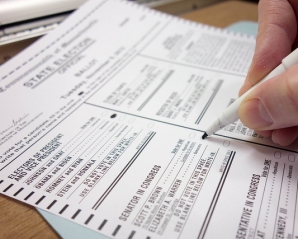
Paper Ballots Key to Election SecurityBy Michael Blume, Manager, Government and Industry Affairs, AF&PA  According to a report released by the Senate Intelligence Committee detailing the extent of America's electoral vulnerability, "paper ballots and optical scanners are the least vulnerable to cyber attack . . ."
According to a report released by the Senate Intelligence Committee detailing the extent of America's electoral vulnerability, "paper ballots and optical scanners are the least vulnerable to cyber attack . . ."
Sept. 4, 2019 - Our lives' most precious documents are memorialized on paper. Marriage and birth certificates, deeds, diplomas, family photos and letters from loved ones are all safeguarded on the printed page. Although there are exceptions in this increasingly paperless world, there is an undeniable link between the permanence and tangibility of physical documents and our attachment to them. Important information belongs on paper and should be shielded from broken hard drives, data breaches and foreign hackers. Paper is personal, permanent, safe and confidential. The hallmark of our democratic system — the ballot — is rushing into an uncertain digital future. As Americans are becoming aware of the constant threat of election interference from foreign actors, the lack of paper ballots is a clear weakness. According to a report released by the Senate Intelligence Committee detailing the extent of America's electoral vulnerability, “[p]aper ballots and optical scanners are the least vulnerable to cyber attack; at minimum, any machine purchased going forward should have a voter-verified paper trail and remove (or render inert) any wireless networking capability.” According to a POLITICO survey, voters in 14 states participated in the 2018 elections using machines that failed to produce an auditable, verifiable paper ballot. These states included key swing states such as Florida and Pennsylvania. Citing a lack of funding, procedural issues or necessity, many election administrators have noted that they have no intentions to depart from paperless voting. To fully secure our elections, these administrators must recognize the threat facing our nation. The education gap regarding this issue is one of the most significant roadblocks facing positive action to protect the ballots of thousands of American citizens. The decentralization of our electoral system provides a high level of security, yet it is imperative that critical information is disseminated to decision makers that can make a difference. However, there is a bright side. States, counties and municipalities are transitioning to either exclusive use of paper ballots or encouraging the use of a physical paper trail. Louisiana, Georgia and South Carolina all plan to be paper-protected by the 2020 elections with hundreds of counties in other states following suit. POLITICO's analysis (as noted above) provides a helpful guide to the status of each of these jurisdictions' efforts. In fact, the value of paper ballots appears to be one of the few issues both Republicans and Democrats agree on in principle — albeit not in implementation. In a 2018 response to a question regarding election security, POLITICO reports President Donald Trump stated, “[o]ne of the things we're learning is, it's always good — It's old-fashioned — but it's always good to have a paper back-up system of voting…It's called paper. Not highly complex computers, paper. A lot of states are doing that. They're going to a paper back-up. And I think that's a great idea.” Meanwhile, a majority of the Democratic presidential primary candidates have integrated paper ballots into their policy platforms. Americans' ability to vote in free and fair elections has been protected by thousands of men and women in our nation's armed forces. It is our job to ensure that ballots are protected and safe from tampering in a physical paper form. The American Forest & Paper Association (AF&PA) serves to advance a sustainable U.S. pulp, paper, packaging, tissue and wood products manufacturing industry through fact-based public policy and marketplace advocacy. AF&PA member companies make products essential for everyday life from renewable and recyclable resources and are committed to continuous improvement through the industry's sustainability initiative— Better Practices, Better Planet 2020. The forest products industry accounts for approximately four percent of the total U.S. manufacturing GDP, manufactures nearly $300 billion in products annually and employs approximately 950,000 men and women. The industry meets a payroll of approximately $55 billion annually and is among the top 10 manufacturing sector employers in 45 states. Visit AF&PA online at www.afandpa.org or follow us on Twitter @ForestandPaper.
SOURCE: AF&PA |